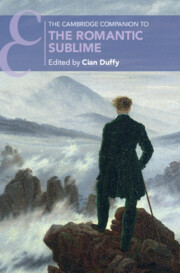Book contents
- The Cambridge Companion to the Romantic Sublime
- The Cambridge Companion to the Romantic Sublime
- Copyright page
- Contents
- Figures
- Contributors
- Abbreviations
- Introduction
- Part I The Sublime before Romanticism
- Part II Romantic Sublimes
- 5 German Romanticism and the Sublime
- 6 The Romantic Sublime and Kant’s Critical Philosophy
- 7 Alpine Sublimes
- 8 Urban Sublimes
- 9 Highlands, Lakes, Wales
- 10 Science and the Sublime
- 11 Musical Sublimes
- 12 The Arctic Sublime
- 13 The Body and the Sublime
- 14 The Sublime in Romantic Painting
- 15 From the Sublime to the Ridiculous
- 16 The Sublime in American Romanticism
- Part III Legacies
- Further Reading
- Index
- Cambridge Companions To …
14 - The Sublime in Romantic Painting
from Part II - Romantic Sublimes
Published online by Cambridge University Press: 06 July 2023
- The Cambridge Companion to the Romantic Sublime
- The Cambridge Companion to the Romantic Sublime
- Copyright page
- Contents
- Figures
- Contributors
- Abbreviations
- Introduction
- Part I The Sublime before Romanticism
- Part II Romantic Sublimes
- 5 German Romanticism and the Sublime
- 6 The Romantic Sublime and Kant’s Critical Philosophy
- 7 Alpine Sublimes
- 8 Urban Sublimes
- 9 Highlands, Lakes, Wales
- 10 Science and the Sublime
- 11 Musical Sublimes
- 12 The Arctic Sublime
- 13 The Body and the Sublime
- 14 The Sublime in Romantic Painting
- 15 From the Sublime to the Ridiculous
- 16 The Sublime in American Romanticism
- Part III Legacies
- Further Reading
- Index
- Cambridge Companions To …
Summary
This chapter examines the reception of philosophies of the sublime in European painting of the Romantic period. In the late eighteenth and early nineteenth century, many painters took up subjects that echo descriptions of the sublime offered by Burke, Kant, and other philosophers, prompted by art critics who attempted to apply the idea of the sublime to art. The chapter focuses on artists who engaged with three facets of the sublime that had become recurrent concerns of British and German philosophical aesthetics: (1) vastness, captured in landscapes of towering mountains and the open ocean; (2) power, expressed through the imagery of volcanic eruptions and other natural disasters; and (3) violence, depicted in paintings of animal conflict.
Keywords
- Type
- Chapter
- Information
- The Cambridge Companion to the Romantic Sublime , pp. 178 - 192Publisher: Cambridge University PressPrint publication year: 2023

